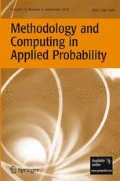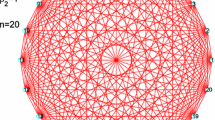Abstract
Random network models generated using sparse exchangeable graphs have provided a mechanism to study a wide variety of complex real-life networks. In particular, these models help with investigating power-law properties of degree distributions, number of edges, and other relevant network metrics which support the scale-free structure of networks. Previous work on such graphs imposes a marginal assumption of univariate regular variation (e.g., power-law tail) on the bivariate generating graphex function. In this paper, we study sparse exchangeable graphs generated by graphex functions which are multivariate regularly varying. We also focus on a different metric for our study: the distribution of the number of common vertices (connections) shared by a pair of vertices. The number being high for a fixed pair is an indicator of the original pair of vertices being connected. We find that the distribution of number of common connections are regularly varying as well, where the tail indices of regular variation are governed by the type of graphex function used. Our results are verified on simulated graphs by estimating the relevant tail index parameters.


Similar content being viewed by others
Data Availability
The datasets generated during and/or analyzed during the current study are available from the corresponding author on reasonable request.
References
Aldous DJ (1981) Representations for partially exchangeable arrays of random variables. J Multivar Anal 11(4):581–598
Barabási A, Jeong H, Néda Z, Ravasz E, Schubert A, Vicsek T (2002) Evolution of the social network of scientific collaborations. Physica A: Statistical mechanics and its applications 311(3):590–614
Bingham NH, Goldie CM, Teugels JL (1989) Regular variation, volume 27 of Encyclopedia of Mathematics and its Applications. Cambridge University Press, Cambridge
Bloznelis M, Kurauskas V (2016) Clustering function: another view on clustering coefficient. J Complex Networks 4(1):61–86
Borgs C, Chayes JT, Cohn H, Holden N (2018) Sparse exchangeable graphs and their limits via graphon processes. J Mach Learn Res 18(210):1–71
Borgs C, Chayes JT, Cohn H, Veitch V (2019) Sampling perspectives on sparse exchangeable graphs. Ann Probab 47(5):2754–2800
Caron F, Fox EB (2017) Sparse graphs using exchangeable random measures. J R Stat Soc Ser B Stat Methodol 79(5):1295–1366
Caron F, Panero F, Rousseau J (2020) On sparsity, power-law and clustering properties of graphex processes. Arxiv preprint arXiv:1708.03120
Das B, Ghosh S (2021) Growth of common friends in a preferential attachment model. Stoch Model 37(3):427–447
de Haan L, Resnick SI (1987) On regular variation of probability densities. Stochastic Processes and their Applications 25:83–93
Diaconis P, Janson S (2008) Graph limits and exchangeable random graphs. Rendiconti di Matematica e delle sue Applicazioni. Serie VII 28(1):33–61
Gradshteyn I, Ryzhik I (2007) Table of Integrals, series, and products. Academic Press, 7th edition
Gupta P, Goel A, Lin J, Sharma A, Wang D, Zadeh R (2013) WTF: The who to follow service at twitter. In: Proceedings of the 22Nd International Conference on World Wide Web, WWW’13. ACM, New York, NY, USA, pp 505–514
Herlau T, Schmidt MN, Mø rup M (2016) Completely random measures for modelling block-structured sparse networks. In: D. Lee, M. Sugiyama, U. Luxburg, I. Guyon, and R. Garnett (Eds) Advances in Neural Information Processing Systems, vol 29. Curran Associates, Inc., pp 4260–4268
Hoover DN (1979) Relations on probability spaces and arrays of random variables. preprint. https://www.stat.berkeley.edu/~aldous/Research/hoover.pdf
Janson S (2016) Graphons and cut metric on sigma-finite measure spaces. Arxiv preprint arXiv:1608.01833
Janson S (2017) On convergence for graphexes. Arxiv preprint arXiv:1702.06389
Kallenberg O (1990) Exchangeable random measures in the plane. J Theor Probab 3(1):81–136
Kingman JFC (1993) Poisson Processes. Oxford Studies in Probability. Clarendon Press, 1st ed
Liben-Nowell D, Kleinberg J (2007) The link-prediction problem for social networks. J Am Soc Inf Sci Technol 58(7):1019–1031
Lovász L, Szegedy B (2006) Limits of dense graph sequences. Journal of Combinatorial Theory, Series B 96(6):933–957
Moller J, Waagepetersen RP (2003) Statistical inference and simulation for spatial point processes. CRC Press
Naulet Z, Roy DM, Sharma E, Veitch V (2021) Bootstrap estimators for the tail-index and for the count statistics of graphex processes. Electronic Journal of Statistics 15(1):282–325
Newman MEJ (2001) Clustering and preferential attachment in growing networks. Phys Rev E 64(2):025102
Resnick S (1987) Extreme Values, Regular Variation and Point Processes. Springer-Verlag, New York
Resnick S (2007) Heavy Tail Phenomena: Probabilistic and Statistical Modeling. Springer-Verlag, New York
Stam A (1977) Regular variation in \(R_+^d\) and the Abel-Tauber theorem. Technical Report, unpublished, Mathematisch Instituut, Rijksuniversiteit Groningen, August 1977
Todeschini A, Miscouridou X, Caron F (2020) Exchangeable random measures for sparse and modular graphs with overlapping communities. J R Stat Soc Ser B (Stat Methodol) 82(2):487–520
Veitch V, Roy DM (2015) The class of random graphs arising from exchangeable random measures. Arxiv preprint arXiv:1512.03099
Veitch V, Roy DM (2019) Sampling and estimation for (sparse) exchangeable graphs. Ann Stat 47(6):3274–3299
Voitalov I, van der Hoorn P, van der Hofstad R, Krioukov D (2019) Scale-free networks well done. Physical Review Research 1(3):033034
Acknowledgements
The work of B. Das and G. Dai was supported by Ministry of Education Academic Research Fund Tier 2 grant MOE2017-T2-2-161 on “Learning from Common Connections in Social Networks”.
Author information
Authors and Affiliations
Corresponding author
Additional information
Publisher’s Note
Springer Nature remains neutral with regard to jurisdictional claims in published maps and institutional affiliations.
Rights and permissions
About this article
Cite this article
Das, B., Wang, T. & Dai, G. Asymptotic Behavior of Common Connections in Sparse Random Networks. Methodol Comput Appl Probab 24, 2071–2092 (2022). https://doi.org/10.1007/s11009-021-09900-7
Received:
Revised:
Accepted:
Published:
Issue Date:
DOI: https://doi.org/10.1007/s11009-021-09900-7



